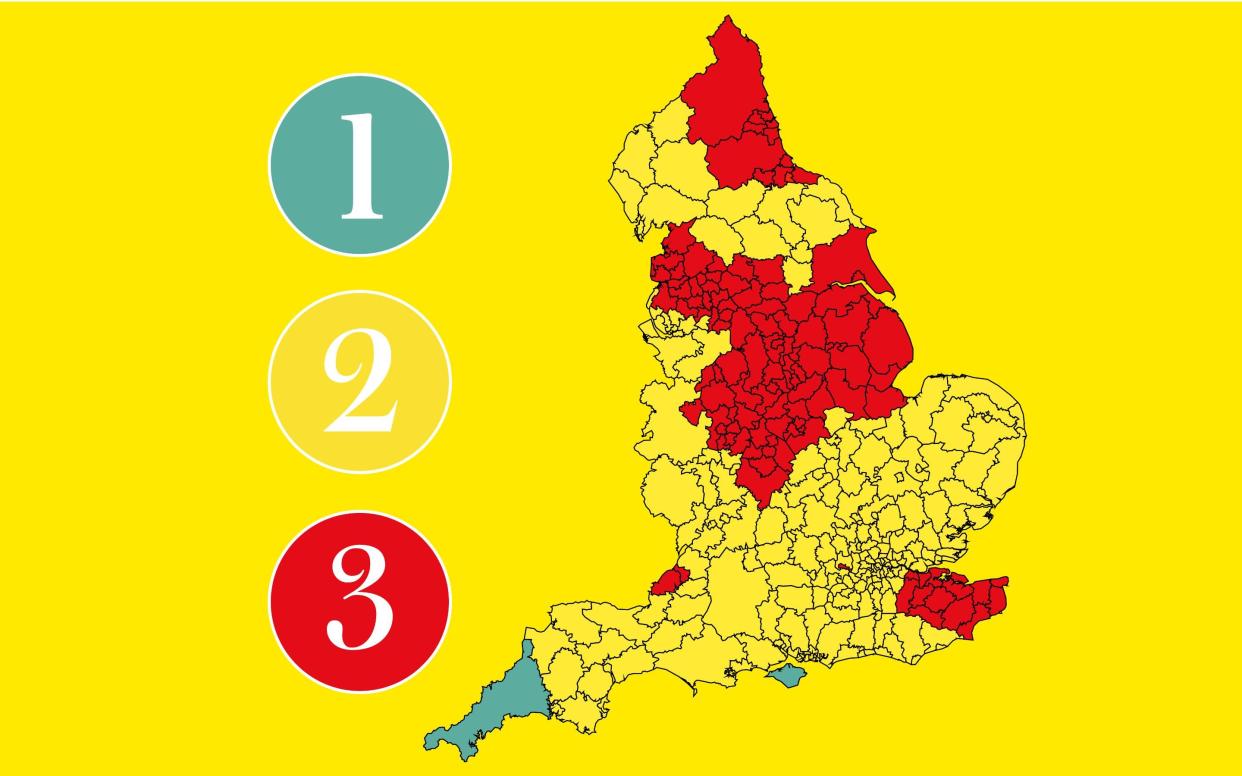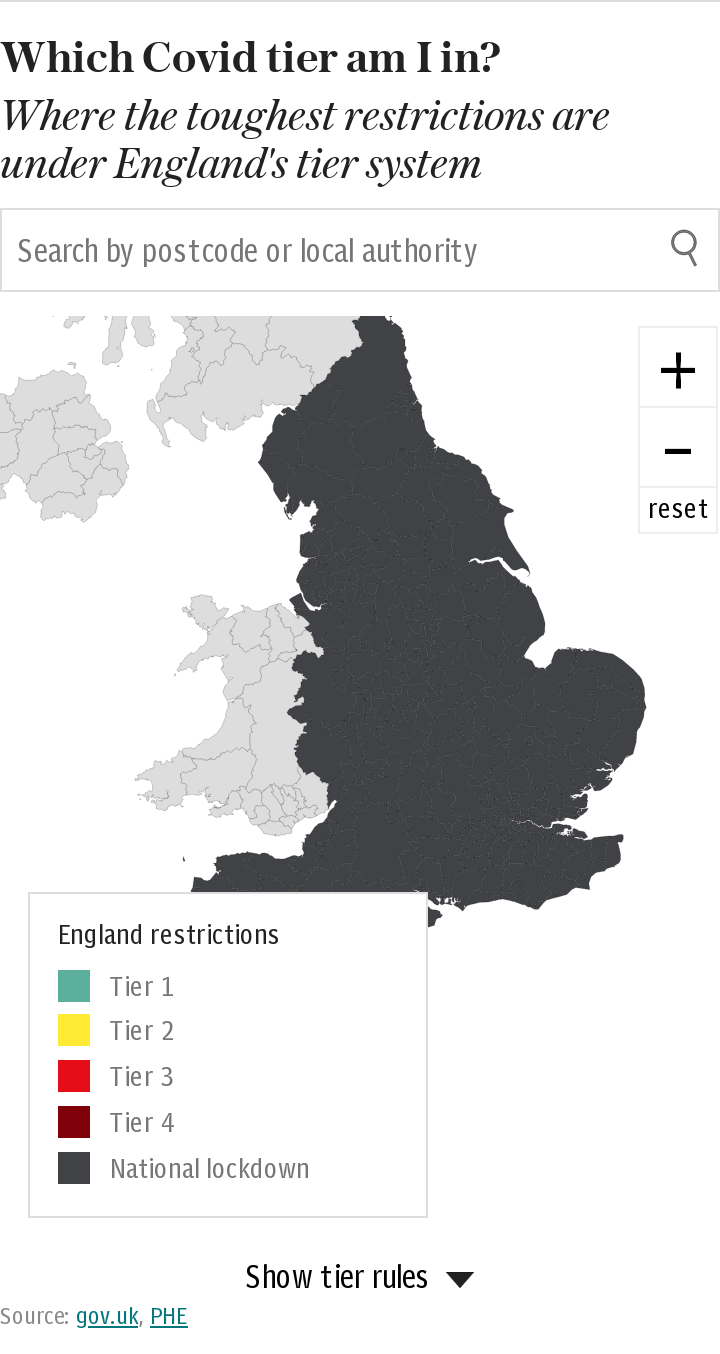Which tier am I in? Use our postcode checker for the latest Covid rules


Manchester, Birmingham, Hull, Newcastle and swathes of the North face the toughest coronavirus restrictions under new tiers, with only three areas - Cornwall, the Isle of Wight and Isles of Scilly - placed into the lowest Tier 1 category.
London will enter Tier 2 along with Liverpool when the national lockdown lifts this week.
Other areas placed in the highest of the Government’s three tiers - either "medium" (Tier 1), "high" (Tier 2) or "very high" (Tier 3) - include Birmingham, Bristol, Kent, Yorkshire and the North East.
MPs are expected to rebel over the plans when they vote on December 1.
The official local lockdown map is based on the number of cases in each area, particularly among people aged over 60, as well as regional pressures on the NHS and testing.
On the evening of November 26, the day the new measures were announced, the Prime Minister said that the tier your area falls under is “not your destiny” and that things will be a lot better by April.
He went on to warn the public not to “take our foot off the throat of the beast now”.
However, Mr Johnson’s decision to introduce this more severe tier-system will cost the economy £900 million a day, according to a leading economic forecaster. This prediction comes after Government ministers refused to share any explanation of the economic consequences of the new three-tier system, and only disclosed more information after pressure from backbench Conservative MPs.
As many as 70 Tory MP’s are expected to oppose the new tier system, however, the Cabinet Office minister, Michael Gove, has argued that the health service could become “overwhelmed” if the strict restrictions are not backed.
The minister also said that MP’s must “take responsibility for difficult decisions” when the harsh measures are voted on this week.
After this backlash from Tory MPs, new reports argue that rural towns and villages near coronavirus hotspots may be saved from the strictest restrictions. Some MPs understand that areas with lower rates of infection could be “decoupled” from the rules of the nearby cities, which have “unfairly” dragged them into the higher tiers.
How many people face severe tier restrictions?
More than 23 million people in England, which is 41.5 per cent of the population, will face the highest tier restrictions once the national lockdown expires on December 2.
This total is constructed of 119 local authority areas, among which Birmingham has the largest population, with 1.1 million people. Meanwhile, Melton in Leicestershire has the smallest population, with 51,200 people.
A further 32.2 million people, 57.3pc of the population, will enter Tier 2 once the current lockdown ends.
How does the level of infection differ between tiers?
Among the 119 locations set to enter Tier 3, only eight are currently showing signs that their Covid-19 cases are rising. Seven of these are located in South East England: Dover, Folkestone & Hythe, Gravesham, Maidstone, Medway, Tonbridge & Malling, and Tunbridge Wells. However, the eighth is Hyndburn in the North West.
While London has fallen into Tier 2, the area of Havering has the highest rate in the tier, and it is higher than 92 of the 119 regions in the higher bracket of Tier 3.
Despite this, the different placement of other neighbouring areas around the country do not fit the pattern of the current case rates. An example of this is seen in Tunbridge Wells in Kent, which will enter Tier 3, which has a rate of 117.9. This is lower than the rate in the adjoining area of East Sussex which has a rate of 161, which has been placed in Tier 2.
The area of South Hams in Devon currently has the lowest rate in the entire county; however, it will enter Tier 2, instead of the lowest tier on December 2.

Areas in Tier 3 (very high alert) will include:
North East
Tees Valley Combined Authority: Hartlepool, Middlesbrough, Stockton-on-Tees, Redcar and Cleveland, Darlington
North East Combined Authority: Sunderland, South Tyneside, Gateshead, Newcastle upon Tyne, North Tyneside, County Durham, Northumberland
North West
Greater Manchester
Lancashire
Blackpool
Blackburn with Darwen
Yorkshire and The Humber
The Humber
West Yorkshire
South Yorkshire
West Midlands
Birmingham and Black Country
Staffordshire and Stoke-on-Trent
Warwickshire, Coventry and Solihull
East Midlands
Derby and Derbyshire
Nottingham and Nottinghamshire
Leicester and Leicestershire
Lincolnshire
South East
Slough (remainder of Berkshire is tier 2: High alert)
Kent and Medway
South West
Bristol
South Gloucestershire
North Somerset
Areas in Tier 2 (high alert) will include:
North West
Cumbria
Liverpool City Region
Warrington and Cheshire
Yorkshire
York
North Yorkshire
West Midlands
Worcestershire
Herefordshire
Shropshire and Telford & Wrekin
East Midlands
Rutland
Northamptonshire
East of England
Suffolk
Hertfordshire
Cambridgeshire, including Peterborough
Norfolk
Essex, Thurrock and Southend on Sea
Bedfordshire and Milton Keynes
London
All 32 boroughs plus the City of London
South East
East Sussex
West Sussex
Brighton and Hove
Surrey
Reading
Wokingham
Bracknell Forest
Windsor and Maidenhead
West Berkshire
Hampshire (except the Isle of Wight), Portsmouth and Southampton
Buckinghamshire
Oxfordshire
South West
South Somerset, Somerset West and Taunton, Mendip and Sedgemoor
Bath and North East Somerset
Dorset
Bournemouth
Christchurch
Poole
Gloucestershire
Wiltshire and Swindon
Devon
Areas in Tier 1 (medium alert) will include:
South East
Isle of Wight
South West
Cornwall
Isles of Scilly
What are the new rules and how long will they last?
The new Covid Winter Plan brings an end to England's stay-at-home order, and allows for the reopening of shops, gyms, personal care and the leisure sector.
Collective worship, weddings and outdoor sports can resume and people will be no longer limited to seeing one other person outdoors, as the rule of six returns once more.
Hospitality can reopen in the two lowest tiers, with the 10pm curfew tweaked into a 10pm last orders. In tier three, sales are restricted to takeaways and delivery.
These tiers will remain in place until March at the earliest, however, the placement of each area in each tier will be reviewed every two weeks.
In a press briefing on November 26, the Prime Minister explained how the stricter tier system would “strike a balance” and that every area has a “means of escape” and the potential to move down a tier.
How are the tiers decided?
Decisions on tiers are made by ministers based on public health recommendations informed by the following factors:
Case detection rate (in all age groups and, in particular, among the over- 60s);
How quickly case rates are rising or falling;
Positivity in the general population;
Pressure on the NHS – including current and projected (3-4 weeks out) NHS capacity – including admissions, general/acute/ICU bed occupancy, staff absences; and
Local context and exceptional circumstances such as a local but contained outbreak.
If these indicators are not improving, an area may be moved up a tier and if the trajectory improves, the area may move to a lower tier.
Can I see family and friends at Christmas?
Families will be able to stay together and form a “Christmas bubble” from Dec 23 to Dec 27.
Travel restrictions are also being lifted, allowing people to visit families in other parts of the UK.
In particular Northern Ireland has negotiated a seven-day suspension of the Christmas rules to help people who need to catch flights or ferries to the mainland. It will run from Dec 22 to Dec 28.
Grottos allowed, but no sitting on Santa's lap
Grottos will be allowed to open across all tiers, new government guidance confirms, but sitting on Santa’s lap will be banned.
Venues must put in place appropriate Covid-secure measures and families will be required to maintain social distancing from Father Christmas.
Door-to-door carol singing will also be permitted as long as groups are outdoors and keep apart from each other.
However, those in Tier 3 will not be able to attend school nativity plays and will have to live stream or watch a recording instead.
Performances will need to be within existing school bubbles, with no mixing across groups.
In Tiers 1 and 2 audiences will be able to attend “subject to appropriate safeguards being in place”.
When will tiers be reviewed?
The first review point for the current tier allocations will take place by December 16.
This allows for the possibility of areas which continue to make progress in slowing the spread of the disease to be moved down a tier in advance of Christmas.
What about the rest of the UK?
In Scotland, on November 26, the Government set a cap of eight people over 12 years old for Christmas gatherings. They also emphasised that households should remain two metres apart while inside. Scotland has imposed a country-wide travel ban and imposed Tier 4 restrictions across 11 of its central and western areas, including Glasgow. These restrictions will remain in place until Dec 11.
In Wales, tighter Covid restrictions are to be put in place from December 4 as cases start to rise.
Northern Ireland began another circuit-break lockdown on Nov 27, just one week after the last one finished, with all non-essential retail, restaurants and hairdressers closed for a fortnight, but schools, small weddings and funerals remain open.
Got a question about the new tiers system? Comment below or email yourstory@telegraph.co.uk for your questions to be answered by our experts.

